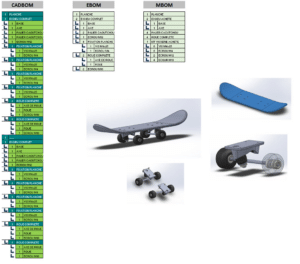The management of its BOM is essential regardless of the type of BOM (eBOM, mBOM, cadBOM, ...), and even more productive related to PLM
Anyone who has already manage the BOM knows the challenges and complexities involved. Sometimes, it is asked to manage a unique BOM, and it is already difficult.
So, why should we manage other forms?
A BOM is a way of seeing the product’s organization.

You said eBOM, cadBOM, mBOM, the difference between each of them may seem unclear. Yet, each of these BOMs corresponds to a different need for information, depending on its positioning (design office, production, shipping, assembly …). Let introduce these notions.
First of all, the “BOM” is an abbreviation for “Bill Of Material”. It is a list of components or documents that will constitute the product’s definition. Then, this organization will be modulated depending on the use or the vision we want to have.
The Design Office, with the generalization of 3D design, knows very well the structure of products according to the CAD construction tree. This layout answers to drawing rules, constraints, … With adapted tools, we are able to extract this tree structure, more commonly called the cadBOM.
This cadBOM can be used as a basis for work, but it only contains what has been “drawn”. In the end, it will have to be completed with the other components (glues, greases, …) and redesign to give a functional vision of the product that will allow a better management of modifications or evolutions. This BOM will become what we call the eBOM (engineering BOM).
The Design Office is expected to produce an eBOM, which corresponds to the technical (and functional) definition of the products. It is the composition of the final product, that is to say it is composed by all the components necessary for the product.
The eBOM is the product’s reference nomenclature (as designed).
After designing, you must buy, manufacture, send, maintain or renovate. All of these steps require specific groupings or rearrangements.
To produce, it is necessary to structure the BOMs according to many criteria such as manufacturing sites, supply chain, production means, manufacturing processes, etc. This is where mBOM (manufacturing BOM) take action with their variants or alternatives. These mBOMs are often controlled by personnel assigned to industrial methods, in close collaboration with logistics and purchasing. They use the eBOM repository as a starting point and reorganize them to produce mBOMs based on their constraints.
Other additional BOMs exist to complete the product management such as repair bill of materials, spare parts kit, and so on.
But, all players will be concerned to keep a direct relationship between the vision they have of the product and the reference eBOM that can evolve. The goal is:
Very often, the mBOM and the process are sent to the ERP which will ensure the production and realization of the product, and will manage the configuration as delivered.
If the after-sales services are provided and there is a willingness to follow the installation, then the configuration will be managed.
It is clear that some ERP systems are not suitable to certain activities with the reception of all these BOMs. The trickiest thing is to make the connection between the reference eBOM and the production variants. It is on these aspects that the PLM, which is close to conception, can bring fluidity and automatisms to facilitate the coherence of these BOMS and their evolutions.
Whatever the composition of your product, it is certain that managing these BOMs and their configurations is essential.
Some issues concerning the BOMs management, within industrial companies, come back regularly. We can identify:
Thanks to Visiativ PLM (formerly Audros), you will be able to manage more easily your different BOMs from different sources of information and store them in a single, centralized database, which will link the different components in order to control more and consider the impact and ensure a total traceability.
The use of eBOM, mBOM and cadBOM will bring you many benefits:
Visiativ PLM offers you a structure without limits allowing you to accommodate all the structures of necessary BOMs to support your different trades in the company. It is a real productivity supplement for your ERP.
Moreover, this multi-organizational management of the product, whether in CAD, in preparation, in production, in logistics, as built or as maintained, allows to center the management and the knowledge of the impact of any changes around the same point.